2021 JohnyMac's 4.8 KWH Off Grid Solar System Build
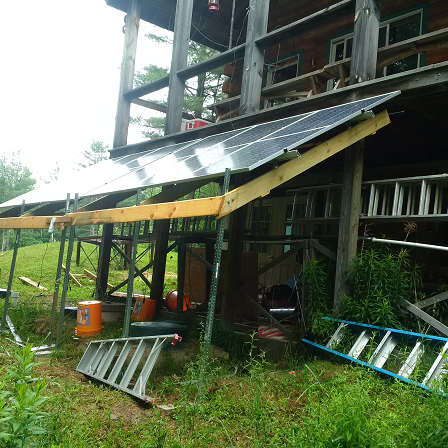
I am going to publish this
off grid solar system review, all on one thread as opposed to three sperate articles. Hence, you will need to return often as I will be adding new information.
The agenda will be> Background of why,
> Set-up outside, racking, and solar panels,
> Setup inside, batteries and electronics, and finally
> Results and overall costs.
We currently have a 4Kw petrol generator that we have used for back-up when the electricity goes down at the redoubt. We hate to turn it on as it is noisy and uses a tank of petrol every 12 hours or so. Typically, we only turn it on when the electric has been out for 8 hours and only for our freezers and refrigerators. The generator is only fired up when I am home. If I am traveling and the electric goes out the neighbor comes over to start it up as my wife just can not do this function. Consequently, we have been looking at adding solar to augment our current needs if the electric goes out for years.
To be self-sufficient, we needed a system that produced 13 Kwh/a day which when I started the process of inquiring into solar, the prices were way above our means - Somewhere in the $18,000- range. This year’s search, I lowered my expectations a bit to 7 Kwh/a day. That estimate came in around $13,000- which was still way above our means.
A bit disillusioned it finally came to me, we were trying to take the generator out of the equation that we only used for the freezers and refrigerator. I did a quick calculation and determined we only needed 3.5Kwh/a day to run the appliances. I asked for a quote from several different companies and all the quotes came back in the $8,200- range which was manageable for our budget.
One of the companies that we had quotes from was running a sale on in-house inventory, so I vetted the company and decided to go with them. The company was
altE. The final cost using a cash discount of 3% was, $7,800-.
We could have probably saved a few additional bucks by piecemealing components from several solar companies however, I wanted one source to go to for,
> Knowledge,
> Product guarantees if something went wrong, and
> A company that made sure I had all the correct components, One and Done.
The shipment arrived 10-days after the purchase via common carrier on 2-pallets. We live in a very remote part of Pennsylvania on a two-track township dirt road. Knowing that there would be nowhere for the 18-wheeler to turn around I met the truck out on the dirt state road. I instructed the truck driver to back up onto my road to a level spot on the road. The tucker was incredibly happy that he did not have to back down the road a half a mile to the cabin. The tuck had a lift gate and pallet jack, so the pallets were off loaded quickly.
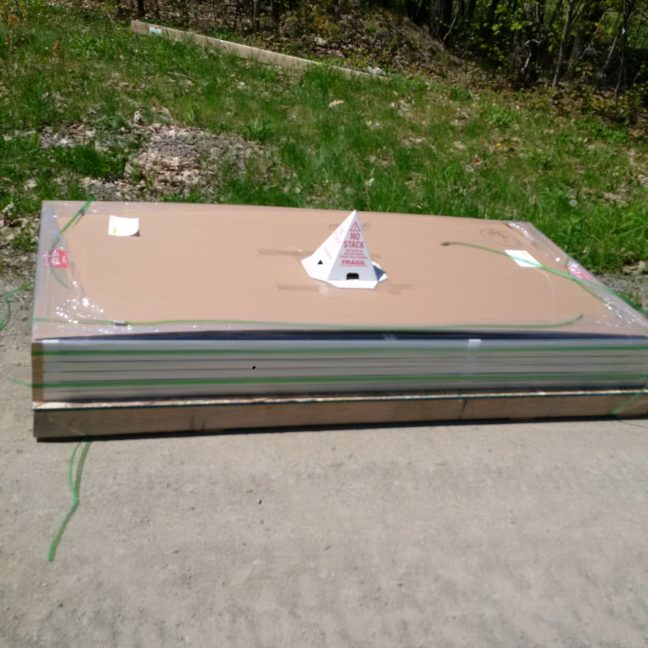
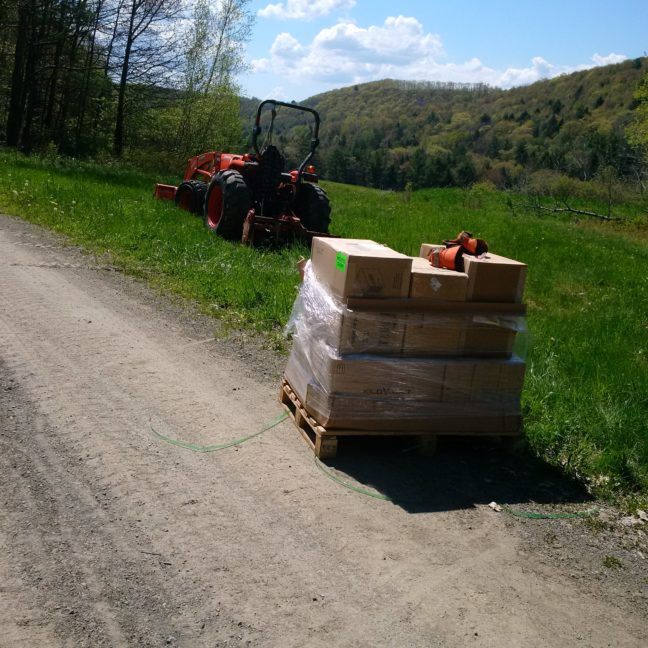
As the truck pulled away, I looked at my watch and thought I would have this loaded into the bucket of my Kubota tractor and into the cellar in about two hours. Plenty of time before lunch - I was wrong.
As I was standing there trying to figure out how to load six, 4' x 7', 67-pound solar panels onto the back of my F150, a turkey hunter came walking down my road returning from his morning spring hunt.
We chatted for a bit and I asked him if he would help me load the panels onto my truck. He whole heartedly agreed and in no time had the truck loaded. Drove the truck down to the cabin and parked it. As I was walking back to the head of the road, I saw my neighbor grabbing a bale of hay for his Scottish Highland Cattle. He asked me what I was up to, and I bent his ear for a few minutes. He offered to help me if needed as he would be around all day.
In no time, my neighbor and I had the solar panels off the truck and stacked near where they will be used. More on that later. Once that task completed, I walked back down the road head to get the rest of the contents of our solar system.
Once the assorted boxes and 11-foot box containing four
IronRidge solar panel rails that the panels will lay on, I was only down to the eight 127-pound deep cycle batteries. They were tough to get onto the tractor bucket but with a lot of pushing and pulling that task was completed, I was off to the cellar the new home for the batteries.
If I thought it was tough getting the batteries off the pallet and onto the tractor bucket, it was twice as hard getting them off the bucket and the 20-feet they needed to travel into the cellar. My shoulder still hurt as I type this article.
I picked up the empty pallets and assorted packaging material and I glanced at my watch and it was 1600 hrs. OUCH!
The plan that
altE and I agreed on was to install the solar panels at ground level for easy maintenance especially in the winter when snow becomes an issue, on the south side of the cabin. The design gave the racking the ability to change angle twice a year to make best use of the angle of the sun.
The racking would consist of two racks of three solar panels each, due to the weight of the racking and panels (estimated at this point 270-pounds per each panel rack). Each rack would be secured at one side to a 1/2-inch black pipe secured to the columns of my porch. The other end would go up and down using 1?-inch perforated square tube nestled into 1 1/2-inch perforated square tube to produce a telescoping column.
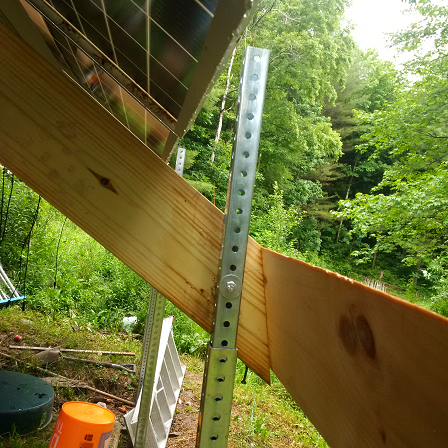 Telescoping columns
Telescoping columns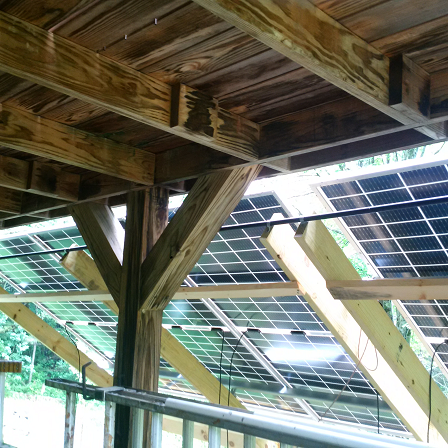 2" x 6" x 8' treated wood beams attached to 1/2" pipe.
2" x 6" x 8' treated wood beams attached to 1/2" pipe.
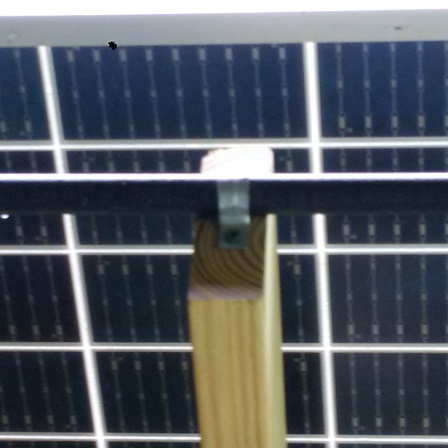 Pipe clamps affixed to end of beams and pipe
Pipe clamps affixed to end of beams and pipeBetween the porch secured black pipe and the telescoping columns were three 2'x 6'x 8' pressure treated wood beams. This is what the 11-feet of solar panel rails are attached too. The solar panels would be secured to are fastened to the rails.
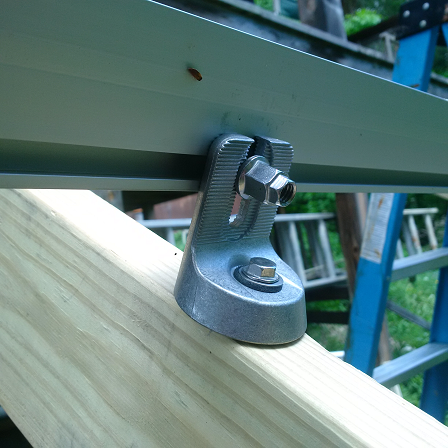 IRONRIDGE 'grip caps' and rails attached to beams.
IRONRIDGE 'grip caps' and rails attached to beams. 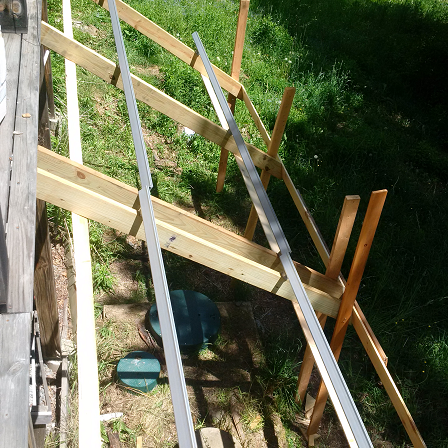 IRONRIDGE panel rails attached to 'grip caps' just before columns are attached.
IRONRIDGE panel rails attached to 'grip caps' just before columns are attached.Due in part to other responsibilities like the garden going in, visiting my mom about three hours away, receiving my tri-axle of wood for the coming winter, et cetera, it took me about ten days to build the racking. All told around 40-hours.
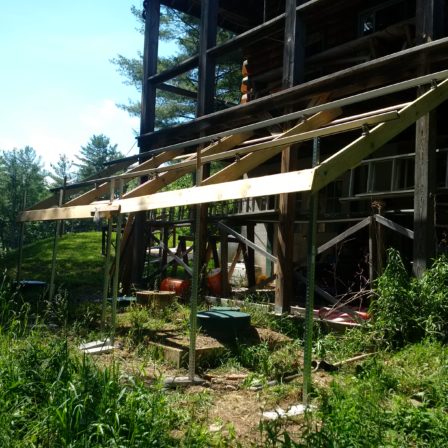 Racking done!
Racking done!Once the racking was completed, I drafted my 17-year-old neighbor to help with putting the solar panels onto the
IRONRIDGE solar panel rails and securing them with specific bolts from the same outfit. The bolts fit into the well thought out rails at the recommended 80 in/pound torque.
Playing with 42"x 7', 67-pound panels over your head in 90-degree unseasonable heat, was not a lot of fun. Working around my neighbor's schedule and life, it took about two weeks to finally finish this part of the build and to stand back and admire the work we had done.
 Panels Up! The racking is done
Panels Up! The racking is doneFeel free to ask any questions using this thread. Over the next couple of weeks, on rainy days that prevent me from cutting firewood and working in the garden, I will be wiring up the system.
Stand by....
